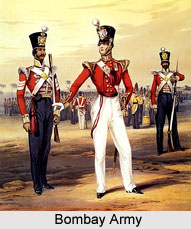 The Bombay Army was the armed force of Bombay Presidency in British India and one of the 3 major Presidency Armies in British India. The British Presidency Armies belonged to the British East India Company. But after the Great Revolt of 1857, also known as Sepoy Mutiny, the British Empire took control over the British East India Company and the three Presidency Armies, namely the Bombay Army, the Bengal Army and the Madras Army. In the year 1895, the 3 separate presidency armies were united to form the combined British Indian Army.
The Bombay Army was the armed force of Bombay Presidency in British India and one of the 3 major Presidency Armies in British India. The British Presidency Armies belonged to the British East India Company. But after the Great Revolt of 1857, also known as Sepoy Mutiny, the British Empire took control over the British East India Company and the three Presidency Armies, namely the Bombay Army, the Bengal Army and the Madras Army. In the year 1895, the 3 separate presidency armies were united to form the combined British Indian Army.
The Government of India Act 1858, which was authorized after the Sepoy Mutiny in the year 1857, transferred the direct authority of the 3 Presidency Armies to the British Empire in India. Later in the year 1903, the 3 Presidency Armies in British India were amalgamated in order to form the unified British Indian Army. The Army of the province of Bombay was involved to a great extent in the defeat of Tipu Sultan, the ruler of the Sultanate of Mysore. Later the Bombay Army also participated in various other campaigns, like the First Anglo Afghan War.
The Army of Bombay Presidency consisted of various esteemed units including the Bombay Grenadiers, which are presently known as the Grenadiers. The Bombay Grenadiers was established from grenadier companies of subsisting regiments in the year 1784. It also included the Maratha Light Infantry.
This article is a stub. You may enrich it by adding more information to it. You can send your write-up at content@indianetzone.com



















